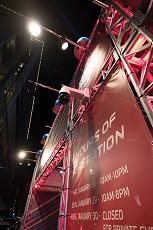
Temporary sites are employed for varying uses, spanning multiple industries and sectors. These can range from makeshift hospitals and construction projects where permanent buildings are not necessary or feasible, through to sporting events and music festivals to offer shelter or provide suitable eating areas. Such buildings, erected quickly and for a limited amount of time, are becoming more common, yet are often poorly secured, largely as a result of traditional surveillance solutions being deemed costly and complex to install in a non-permanent setting. This lack of protection can lead to theft and criminal damage, and can ultimately leave people vulnerable.
Physical security has advanced considerably, moving away from legacy standalone CCTV systems to modern digital video surveillance technologies. These IoT enabled devices are capable of providing high quality video and live data that can be analysed to produce powerful insights. Such solutions also offer an ease of connectivity that can support a move away from wired networks to utilise mobile connectivity. This provides more scope for the protection of structures in areas where cabled network connections are not possible. This makes security achievable in even the most remote locations.
Demands for physical security systems that are not only quick and easy to deploy, but also offer flexibility to adapt to different needs, are increasing. The latest solutions represent a cost-effective and high-quality option in settings where the alternative choice usually means having no security provision at all. Temporary hospitals are one such example of a structure that is becoming more prevalent and has unique security needs. Whether established to provide aid in a conflict situation, or to support general hospitals in the fight against COVID-19, this type of space necessitates the implementation of comprehensive security measures.
Surveillance becomes crucial in safeguarding equipment, medicines, PPE and other supplies. Security cameras, combined with audio, can serve to detect and deter those attempting to enter a site without authorisation, with visual detection triggering an automated audio response. The addition of access control technology allows greater control of entrance and exit points, minimising the risk of criminals gaining access to a site, but also of use in restricting public access where the spread of COVID-19 or other contagions is a concern. Door control systems can be used as communication devices between staff and patients, helping to minimise unnecessary patient contact, and prioritise resources.
A security solution that does not rely on network cables or static power sources can provide a truly flexible, scalable and reliable surveillance system. In the construction industry, at road construction sites and other temporary locations, intrusion, interruption, and injury are three of the most common threats. Dedicated surveillance systems make high quality, remotely managed supervision possible, thereby minimising risk. Using surveillance and audio technologies to alert teams to danger can prove invaluable from a health and safety perspective, helping to avoid accidents, while also documenting high quality video of any situation to aid incident investigation.
In addition, security solutions used at the perimeter of a site or working area can secure against unauthorised access, vandalism, and the theft of materials, tools and machinery. It is estimated that the construction industry suffers millions of pounds in loss each year due to vandalism and theft, so taking effective measures to protect the assets held at non-permanent locations and within temporary structures helps mitigate this. Such surveillance solutions provide high-quality 24-hour incident detection, are cost-effective, and easily set up and maintained.
Being able to effectively secure temporary sites and the structures within them presents a huge leap forward in the capabilities of physical security solutions. With businesses and operations securely guarded when away from a fixed premises or site, the possibilities afforded by temporary sites increase when security limitations are removed. Modern business models allow customisable and scalable solutions which can be delivered to meet exact requirements, meaning that video surveillance, IP audio, access control and remote management are now feasible across any site and in any configuration. Vendors are already seeing a demand for such services. Where rapid installation of a powerful security system is required in a temporary setting, smart innovations in deployable security present the ideal solution.











